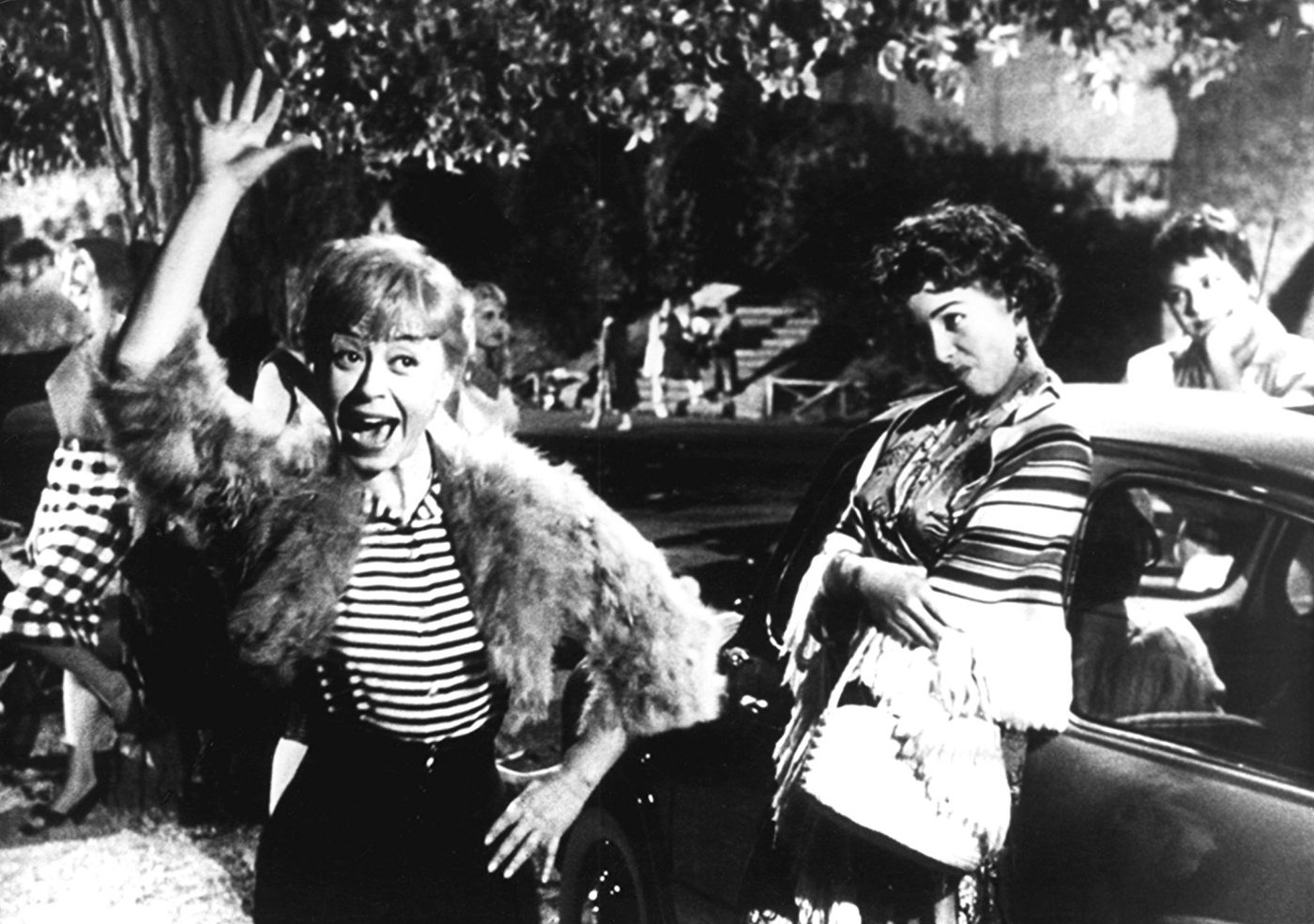by James Kerans
All the Fellini virtues are here: the fluent camera, the wit, the elegant composition, the theme-and-variations style, the melange of theatrical and religious symbol, the parabolic eloquence, the vocabulary of private motifs. La Strada is more exciting, because it calls for the management of material more coarse, more extravagant, more dangerous, more mysterious. But in Cabiria Fellini’s finesse is more impressive. His command is so easy it becomes almost idle, and we are sure to hear him accused of facility and decadence. Nevertheless, he here confirms his position as the greatest master now steadily producing films.
The center of the film is Cabiria, a good-natured small-time whore. She is our entree into a series of backgrounds: the Caracalla baths, an outdoor staging area for The Trade; the world of loud bachelor chic into which she is briefly bought by a movie star crossed for the moment in love; a hectic, theatrical shrine, dense with believers in search of miracles; a kitschy theater presided over by a hypnotist; the spacious, nondescript byways of Rome, where she strolls with François Périer, her gentle betrayer. Everywhere Fellini makes Masina’s responsiveness a vivid foil to the life around her, and there is so much plausible delight and drama in the simple shock of her intrusions that they alone nearly satisfy us. But under this literal flower is a strong formal scheme.
The story line is plain: Cabiria, robbed and abandoned by one boy friend, picks up for us her night- (and day-) life. Because she is looking (and vaguely planning) for an escape from it, she walks into a gross confidence trap set by François Périer, who promises to marry her, then runs away with her money. But this sturdy cliche in turn supports the film’s real form, which is lyrical, the expansion of a germinal formula into a dramatic meditation.
The opening (key) episode is almost a parody of neorealismo melodrama. Cabiria, fond and gladsome, leads her punk (not Périer) to the river at the city’s edge. He snatches her purse, pushes her in, and flees. Some boys pull her out and hand her over to a group of men who, neo-realistically, pump her dry. When she awakes, she storms off, surly and ungrateful. The film then undertakes to transfigure this formula, to invert it, to give it religious, humane, and artistic dignity.
One measure of Fellini’s style is to contrast the quality of the opening and closing passages of the film. The opening statement is in flat daylight, the camera distant, caustic, the motives neglected, the action abrupt, ugly, journalistic. The development, by contrast, is beautifully various in its staging, the camera endlessly caressive and sympathetic, the dramatic inspection microscopic, the action delicate and suggestive. The reprise at the end is positively operatic in its amplification of the initial formula. The purse is now Cabiria’s whole treasure, the locale is a glamorous cliff over deep water, twilit by a “strange light,” the punk is now the sensitive, guilty (even this luxury Fellini can afford!). Périer, and the return to life is at first a solitary survival of humiliation and loss, then a dazzling welcome among children singing in the dark wood. This circling back has a formal value, but it also forces us to accept the repetition of trust and betrayal as Cabiria’s destiny, whether it appears as a dingy accident or as a subtly studied complex of “things as they are” in her nature and in “the world.” The beautiful sustained smile of the dose is thus no vulgarly hopeful “Better luck next time,” nor is it even a sign of accepted consolation. It is the sign of surviving grace, of a pure nature persisting, free, in its purity.
Grace, really, is the subject of the film. The sense that Cabiria is “chosen,” whether as victim or redeemed, is established by various devices, but most directly by the number of times (and ways) she is “called” or singled out. As a prostitute she is of course open to calls, but Fellini converts this plausible condition into a significant one. Over and over again Cabiria is called—nearly always from behind (this obvious but unobtrusive device must appear a dozen times): she does not essentially seek to be chosen; and she usually responds with, “A me? [Who, me?],” looking for reassurance. If we ask by what sour analogy we must find, in the random, negligent, or sinister “lovers” who dispose of Cabiria’s destiny, emblems of Cod, we may discover a rather lurid cynicism; but we would be unjust to Fellini. The lovers may choose her as a victim, but if they are emblems of any disposing deity, it is the god of deceit and gimcrack façade which Fellini exposes in his “church” scenes. But the impulse by which she calls herself Maria suggests a divine appointment clear of the welter of masquery which is Fellini’s governing vision of life. We may not know what power has graced her, but the tribute is offered still.
Of Masina we need only say that, as in La Strada, her gift is the very moral of the drama. Hilarious and moving though she is, her inexhaustible, vivid candor is no mere tour de force, but a declaration of life. Under the cunning tics and grimaces, the reckless awkwardnesses of costume and gesture, there persists the angelic image that tames the spectators at her hypnotic scene.
The only just praise of Fellini’s planning and direction is a close commentary. In stylish technical work and symbolic density (the title, with its hints at myth and garish romance, is an example) Cabiria has some of his best work. If his repetition of symbols (the sea, or “back-stage” religion) shows a tendency to manner, the tendency is at least still gathering excitement; and at present no one else promises so much.
Film Quarterly, Vol. 12 No. 1, Autumn, 1958 (pp. 43-45)





